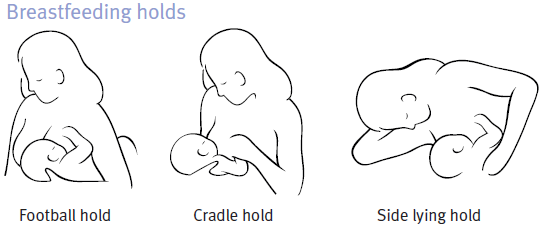Latching problems
A proper latch is necessary for successful and pain-free breastfeeding. The term latching on describes your baby taking the nipple and the entire areola into their mouth. Latching on properly means that your baby can get a sufficient amount of milk and that your nipples are protected from becoming sore and cracked. Poor latch can also lead to a reduction in breast milk production and your baby may not be gaining weight as quickly as you would like. Latching problems happen frequently and are very common. It is extremely important to geta good start as quickly as possible (preferably within the first hour from delivery) and to tackle any issues that show up along the way.
How to recognise a good latch
When the baby is latched on properly, the entire nipple and the surrounding areola are in their mouth, with the nipple positioned towards the back of the baby’s mouth. Baby’s tongue is covering the bottom teeth, protecting the nipple from possible damage. That is why we say that although breastfeeding can be slightly uncomfortable at first, as long as good latch is accomplished, it should not be painful.
Other signs of a good latch include feeling a slight tugging feeling on your breast and observing your baby swallowing the milk. Additionally, if you’re not in pain and if your baby is gaining weight steadily, chances are you’ve got breastfeeding under control.
Poor latch should be interrupted – slide your finger gently in between your baby’s lips in the corner of the mouth and allow some space for your nipple to come out. Once the latch is broken, try again.
How to help your baby latch on properly
Breastfeeding takes some time, so make sure to position yourself correctly first. You can sit in a reclined position or lie down, whatever suits you better. Have a bunch of pillows ready to provide support to your back, head or slide them between your knees. If possible, nurse in a darkened, quiet room with minimal distractions. This will help both you and your baby relax and ease into breastfeeding. However, your baby shouldn’t be so relaxed that he falls asleep – wake your baby up gently by touching their feet or moving their legs.
There are several holds you could use to achieve a proper latch – cradle the baby in your arms while they’re lying in front of you, hold them tucked under your arm like a football, or have them lie next to you on the bed. Whatever position works best for you, the guidelines are the same – the baby’s head and body should be turned towards your breast and pulled closely to your body. The baby’s head should be in the same level as the nipple so that they do not need to strain in order to reach it.
Next, take your breast into your hand and squeeze it slightly to express a few drops of milk. Breast milk is a great way to protect the nipple from damage and cracking, but it will also serve as a signal for your baby to open their mouth and accept the nipple. Use your hand to direct the nipple towards the back of the baby’s mouth and before the baby’s mouth closes around your nipple, pull them closer to you. The baby’s chin should be pressed into the breast, with the nose pulled slightly away, so that breathing is not disturbed.
If you are having trouble with latching on, do not hesitate to seek help – talk to your physician, a lactation consultant, friend or a family member who has experience with breastfeeding.



